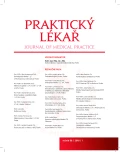Evaluation of nutritional intake of patients after endoscopic gastroplasty
Authors:
K. Petřeková 1,2; P. Svrčinová 1; V. Horká 2; J. Janoutová 1; M. Bužga 2
Authors‘ workplace:
Ostravská univerzita v Ostravě
Lékařská fakulta
; Ústav epidemiologie a ochrany veřejného zdraví
Vedoucí: doc. MUDr. Rostislav Maďar, Ph. D., MBA, FRCPS
1; Ústav fyziologie a patofyziologie
Vedoucí: prof. MUDr. Jaroslav Veselý, CSc.
2
Published in:
Prakt. Lék. 2018; 98(1): 36-41
Category:
Of different specialties
Overview
Purpose:
The study focused on evaluating nutritional intake and monitoring changes in body parameters in obese patients who underwent endoscopic gastroplasty.
Methodology:
A prospective study, assessing the results of 17 patients who underwent endoscopic gastroplasty (13 females, 4 males, age 24–57, where entering average BMI was 37.38 ± 2.54 and body weight was 106.10 ± 12.24 kg). The patients before and after (the first, third, sixth, ninth and twelfth month) the endoscopic surgery have undergone planned checks of the physical parameters and were provided with nutritional counselling. A week before each check the patients recorded all foods consumed over a 7-day period.
Results:
Twelve months after the endoscopic gastroplasty there was a significant reduction in energy intake 963 kJ/day i.e. 13% (p < 0.030), intake of lipids 16,9 mg/day i.e. 21% (p < 0.002), intake of SAFA 5.1 mg/day i.e. 17% (p < 0.012), intake of sodium1157,3 mg/day i.e. 34% (p < 0.001). Nevertheless, the intake of SAFA and Natrium was still above the recommended dose (10 respectively 53 %). There was a significant increase in magnesium intake 55,2 mg/day i.e. 23% (p < 0.039) and calcium intake 236,6 mg/day i.e. 46% (p < 0.001). However, still intake was 9 respectively 25 percent below the recommended dose. There was increased intake of phosphorus 154,6 mg/day i.e. 15% (p < 0.038) and the reference dose was fulfilled on 175 %. There was a negative decrease in the intake of vitamin C, iron and fiber, their reference dose was not filled even before endoscopic surgery. The decrease in daily sodium intake was positive, but after one year, its intake was still on 153% opf the reference dose. Patients had a sufficient intake of vitamin B12. Changes in nutritional intake were affected by changes in food preferences and food tolerance in patients. In patients there was a significant decrease in fat mass on average by 3.5 kg (p < 0.009) and a reduction in waist circumference by 4.4 cm (p < 0.009). The loss of muscle mass was not significant (p < 0.074), which is a positive result with the loss of total body weight. Protein intake was 7% higher than the recommended daily value.
Conclusion:
Endoscopic gastroplasty seems to be a suitable method of the obesity treatment. Patients one year after the endoscopic gastroplasty ago experienced positive changes in the loss of adipose tissue and waist circumference at a relatively insignificant loss of muscle mass. Nutritional counselling which includes assessing a recorded diet, could positively influence the intake of nutrients in patients after endoscopic gastroplasty. Computer evaluation of energy intake and nutrients from dietary records is limited in validity, but can contribute to the right nutrition of patients. With regard to non-compliance with the reference dose of some minerals and vitamins, it would be appropriate to supplement their intake from dietary supplements. .
Keywords:
obesity – endoscopic gastroplasty – energy – nutrients – diet
Sources
1. Deutsche Gesellschaft für Ernährung e.V. D-A-CH Referenzwerte für die Nährstoffzufuhr (online). Dostupné na: http://www.dge.de/wissenschaft/referenzwerte/ (cit. 2017-08-14).
2. Gezondheidsraad. Voedingsnormen energie, eiwitten, vetten en verteerbare koolhydraten. Den Haag: Gezondheidsraad 2001; publicatie nr 2001/19.
3. Huberty V, Ibrahim M, Hiernaux M, et al. Safety and feasibility of an endoluminal-suturing device for endoscopic gastric reduction (with video). Gastrointest Endosc 2017; 85(4): 833–837.
4. Hu FB, Willett WC. Optimal diets for prevention of coronary heart disease. JAMA 2002; 288(20): 2569–2578.
5. Petřeková K, Bužga M, Janoutová J, Machytka E. The importance of nutritional counseling for obese patients undergoing endoscopic procedures. Gastroent Hepatol 2017; 71(3): 245–250.
6. Petřeková K, Bužga M, Janoutová J. Nutriční deficity po bariatrických operacích a jejich úprava suplementací. Prakt. Lék. 2016; 96(2): 82–86.
7. Serra-Majem L, Pfrimer K, Doreste-Alonso J, et al. Dietary assessment methods for intakes of iron, calcium, selenium, zinc and iodine. Br J Nutr 2009; 102(Suppl 1): S38–55.
8. Shim JS, Oh K, Kim HC. Dietary assessment methods in epidemiologic studies. Epidemiol Health 2014; 36: e2014009. doi: 10.4178/epih/e2014009. eCollection 2014.
9. Schroder H, Covas, MI, Marrugar J, et al. Use of a three-day estimated food record, a 72 recall and a food-frequency questionnaire for dietary assessment in a Mediterranean Spanish population. Clin Nutr 2001; 20(5): 429–437.
10. WHO. Diet, nutrition and the prevention of chronic diseases. Report of a joint FAO/WHO expert consultation (online). Dostupné na: http://apps.who.int/iris/bitstream/10665/42665/1/WHO_TRS_916.pdf (cit. 2017-08-14).
Labels
General practitioner for children and adolescents General practitioner for adultsArticle was published in
General Practitioner

2018 Issue 1
Most read in this issue
- Acute renal failure and acute kidney injury
- Violence and aggression to professionals in healthcare facilities
- The current view of carbon monoxide poisoning in the Czech Republic
- The patient has a family! Individualised care from a systemic perspective
